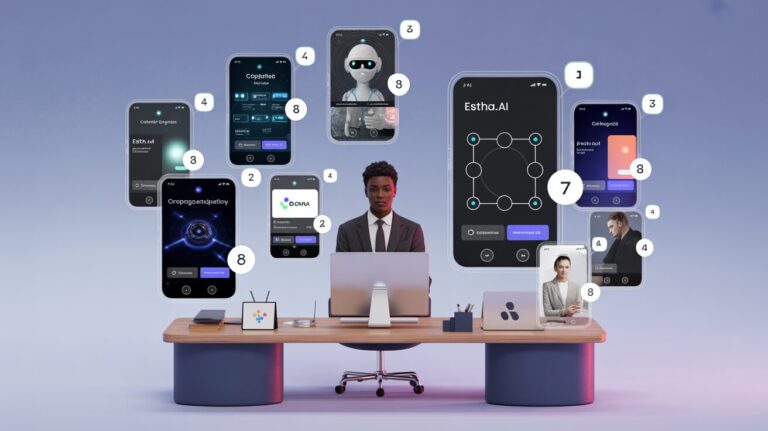Table Of Contents
- Introduction
- What Are No-Code AI Platforms?
- Estha.ai: Revolutionary No-Code AI Application Builder
- Top No-Code AI Platforms Like Estha
- How to Choose the Right No-Code AI Platform
- The Future of No-Code AI Development
- Conclusion
The AI revolution is no longer confined to tech giants and coding specialists. Thanks to no-code AI platforms, professionals across all industries can now harness the power of artificial intelligence without writing a single line of code. These platforms are democratizing AI development, making it accessible to educators, content creators, healthcare professionals, and small business owners.
Among these groundbreaking platforms, Estha.ai stands out with its intuitive drag-drop-link interface that allows anyone to create custom AI applications in minutes rather than months. But how does it compare to other leading no-code AI solutions in the market?
In this comprehensive guide, we’ll explore Estha.ai and eight other top no-code AI platforms that are transforming how we build AI applications. Whether you’re looking to create intelligent chatbots, expert advisors, interactive quizzes, or virtual assistants, these platforms offer powerful tools without the traditional technical barriers.
Top No-Code AI Platforms Like Estha
Democratizing AI Development for Everyone
What Are No-Code AI Platforms?
Software solutions that enable users to build AI applications through visual interfaces, without requiring programming knowledge.
9 Leading No-Code AI Platforms
Estha.ai
Revolutionary drag-drop-link interface with a complete ecosystem for building, learning, scaling, and monetizing AI applications.
Obviously AI
Focuses on predictive analytics and forecasting for business users without data science expertise.
Akkio
Emphasizes speed and simplicity for business users to quickly build and deploy predictive models.
Dasha AI
Specializes in conversational AI with human-like voice assistants and phone-based AI agents.
Make.com
Automation platform with AI capabilities for connecting apps and services in visual workflows.
Appy Pie
Suite of no-code tools including AI-enabled chatbot builder for customer service and engagement.
Voiceflow
Specialized in creating voice and chat applications for platforms like Alexa and Google Assistant.
Bubble
Comprehensive web application platform with AI capabilities through plugins and integrations.
UiPath
RPA platform expanded to include AI capabilities for automating processes with intelligent decision-making.
How to Choose the Right No-Code AI Platform
Understand Your AI Requirements
Define what type of AI application you need to build based on your specific use case.
Evaluate the Learning Curve
Consider how quickly you need to become productive and what learning resources are available.
Consider Integration Needs
Assess how the AI solution will connect with your existing tools and databases.
Assess Scalability
Consider future growth potential including usage volumes and pricing scalability.
The Future of No-Code AI Development
Increasing Sophistication
No-code platforms are approaching the complexity and power previously reserved for code-based development.
Specialized Industry Solutions
Industry-specific platforms incorporating domain knowledge and compliance features for sectors like healthcare and finance.
AI-Assisted Development
AI itself is being used to assist in creating AI applications, further reducing barriers to entry.
Community and Marketplace Growth
Ecosystems allowing users to share templates, components, and complete applications create network effects.
The democratization of AI through no-code platforms enables domain experts to build custom AI applications without technical hurdles, driving a new wave of innovation across every sector.
What Are No-Code AI Platforms?
No-code AI platforms are software solutions that enable users to build, deploy, and manage artificial intelligence applications through visual interfaces, without requiring programming knowledge. These platforms typically feature drag-and-drop components, pre-built templates, and intuitive workflows that abstract away the complexity of AI development.
The core benefits of no-code AI platforms include:
- Accessibility: They open AI development to non-technical users, including subject matter experts who understand their domain but lack coding skills.
- Speed: Development cycles are dramatically reduced from months to days or even hours.
- Cost-effectiveness: Organizations can avoid hiring specialized AI developers or extensive training programs.
- Experimentation: Users can rapidly prototype and iterate on AI solutions without significant resource investment.
- Democratization: They distribute AI capabilities across organizations rather than concentrating them in IT departments.
The rise of no-code AI coincides with a broader shift toward democratization in technology, where complex tools are being reimagined to empower non-specialists to create sophisticated solutions. This transformation is particularly important for AI adoption, as it allows domain experts to directly translate their knowledge into functional applications.
Estha.ai: Revolutionary No-Code AI Application Builder
At the forefront of the no-code AI movement is Estha.ai, a platform designed specifically to make AI application development accessible to anyone, regardless of technical background. What sets Estha apart is its unique approach to simplifying the complex process of AI development.
Key Features of Estha
Estha’s platform is built around a revolutionary drag-drop-link interface that transforms AI development into a visual experience. Users can:
- Build custom AI applications in just 5-10 minutes
- Create applications that truly reflect their expertise and brand voice
- Develop various AI solutions including chatbots, expert advisors, interactive quizzes, and virtual assistants
- Embed their creations into existing websites
- Share and even monetize their AI applications
The Estha Ecosystem
Beyond just building applications, Estha provides a comprehensive ecosystem to support users throughout their AI journey:
EsthaLEARN: Educational resources and training to help users understand AI concepts without getting bogged down in technical jargon.
EsthaLAUNCH: Support for startups and scaling resources to help businesses grow with their AI applications.
EsthaSHARE: Tools and infrastructure for monetization and distribution, allowing creators to generate revenue from their AI solutions.
This holistic approach makes Estha not just a development tool, but a complete platform for turning expertise into functional, profitable AI applications.
Top No-Code AI Platforms Like Estha
While Estha offers a unique approach to no-code AI development, several other platforms have emerged with their own strengths and specializations. Let’s explore eight alternatives that serve different niches in the no-code AI ecosystem.
1. Obviously AI
Obviously AI focuses on making predictive analytics accessible to business users without data science expertise. The platform allows users to create machine learning models by simply uploading data and selecting what they want to predict.
Key strengths:
- Specializes in predictive analytics and forecasting
- Handles both classification and regression problems
- Automatic feature engineering and model selection
- Results are delivered in plain English explanations
Best for: Business analysts and domain experts who need to make data-driven predictions without diving into complex data science.
Compared to Estha: While Obviously AI excels at predictive analytics, it doesn’t offer the same breadth of AI application types as Estha. It’s more focused on specific data analysis tasks rather than building interactive AI applications.
2. Akkio
Akkio is a no-code AI platform that focuses on helping business users quickly build and deploy predictive models. The platform emphasizes speed and simplicity, allowing users to go from data to prediction in minutes.
Key strengths:
- Rapid model building and deployment
- Integration with popular business tools like Salesforce and Hubspot
- Automated machine learning that optimizes models
- Flow-based interface for creating prediction workflows
Best for: Sales, marketing, and operations teams looking to embed AI predictions into their existing workflows and tools.
Compared to Estha: Akkio is primarily focused on predictive analytics and integrations with business tools, while Estha offers a broader range of AI application types with its drag-drop-link interface.
3. Dasha AI
Dasha AI specializes in conversational AI, allowing users to create human-like voice assistants and phone-based AI agents without coding. The platform stands out for its natural-sounding voice interactions.
Key strengths:
- Exceptionally natural voice conversations
- Advanced call handling capabilities
- Visual conversation flow designer
- Multi-language support
Best for: Customer service teams, appointment schedulers, and organizations that heavily rely on phone communications.
Compared to Estha: Dasha’s focus is specifically on voice-based AI interactions, while Estha offers a more versatile platform for various types of AI applications, including but not limited to conversational interfaces.
4. Make.com (with AI capabilities)
Make.com (formerly Integromat) is primarily an automation platform that has incorporated AI capabilities into its workflow. It allows users to connect apps and automate workflows with some AI-powered features.
Key strengths:
- Powerful integration with thousands of apps and services
- Visual workflow builder
- AI modules for text analysis, image recognition, and more
- Combination of automation and AI capabilities
Best for: Teams looking to enhance existing workflows with AI capabilities and automate processes across multiple platforms.
Compared to Estha: Make.com is primarily an automation tool with AI features, while Estha is purpose-built for creating standalone AI applications. Make.com excels at connecting different services, while Estha focuses on building AI solutions from the ground up.
5. Appy Pie
Appy Pie offers a suite of no-code tools including an AI-enabled chatbot builder. Their platform allows businesses to create chatbots for customer service and engagement without technical expertise.
Key strengths:
- Simple interface for chatbot creation
- Integration with popular messaging platforms
- Pre-built templates for common use cases
- Part of a broader no-code ecosystem
Best for: Small businesses and entrepreneurs looking for straightforward chatbot solutions without complexity.
Compared to Estha: Appy Pie’s AI offerings are more limited in scope, primarily focusing on basic chatbots, while Estha provides tools for building more sophisticated and varied AI applications with greater customization.
6. Voiceflow
Voiceflow is specialized in creating voice and chat applications for platforms like Alexa, Google Assistant, and custom interfaces. It offers a visual interface for designing conversational experiences.
Key strengths:
- Specialized in voice and conversational interfaces
- Advanced conversation design capabilities
- Integration with major voice platforms
- Collaborative design features
Best for: Conversation designers and teams building voice applications for specific platforms like Alexa or Google Assistant.
Compared to Estha: Voiceflow is highly specialized in conversational design, particularly for established voice platforms, while Estha offers broader AI application development capabilities across different formats and use cases.
7. Bubble
Bubble is a comprehensive no-code platform for web application development that has increasingly incorporated AI capabilities through plugins and integrations. It allows users to build complex web applications with AI features.
Key strengths:
- Powerful general-purpose application builder
- Extensive plugin ecosystem including AI services
- Database management capabilities
- Highly customizable interface
Best for: Entrepreneurs and product teams looking to build comprehensive web applications with AI features integrated.
Compared to Estha: Bubble is a broader web application platform that can incorporate AI through plugins, while Estha is specifically designed for AI application development with a more streamlined experience for that purpose.
8. UiPath
UiPath began as a robotic process automation (RPA) platform but has expanded to include AI capabilities in its no-code offerings. It allows businesses to automate processes with intelligent decision-making.
Key strengths:
- Strong process automation capabilities
- AI Center for managing AI models
- Document understanding features
- Enterprise-grade security and scalability
Best for: Enterprise teams looking to automate complex business processes with AI-enhanced decision-making.
Compared to Estha: UiPath focuses on process automation with AI components, whereas Estha is centered on creating standalone AI applications. UiPath has stronger enterprise orientation, while Estha emphasizes accessibility for users of all technical backgrounds.
How to Choose the Right No-Code AI Platform
Selecting the ideal no-code AI platform depends on your specific needs, technical comfort level, and intended use cases. Here are key factors to consider when evaluating platforms like Estha and its alternatives:
Understand Your AI Requirements
Before choosing a platform, clarify what type of AI application you need to build:
- Conversational AI (chatbots, voice assistants)
- Predictive analytics and forecasting
- Content generation or enhancement
- Process automation with intelligent components
- Decision support systems
Different platforms excel in different areas. Estha’s strength lies in its versatility across multiple AI application types with its intuitive drag-drop-link interface.
Evaluate the Learning Curve
Consider how quickly you need to become productive with the platform:
- How intuitive is the interface?
- Does the platform provide templates or starting points?
- What learning resources are available?
- Is there a supportive community?
Estha’s focus on making AI accessible through its EsthaLEARN component specifically addresses the learning curve challenge for non-technical users.
Consider Integration Needs
For most businesses, an AI solution needs to work with existing systems:
- Can the platform connect to your current tools and databases?
- How easily can you embed or deploy the AI applications?
- Does it support API connections to custom systems?
Evaluate each platform’s integration capabilities against your specific ecosystem requirements.
Assess Scalability and Growth Potential
Consider not just your current needs, but future growth:
- Can the platform handle increased usage volumes?
- Are there usage limits or performance constraints?
- How does pricing scale with usage?
- Can applications be enhanced or extended over time?
Platforms like Estha with components like EsthaLAUNCH specifically address scaling challenges for growing organizations.
Evaluate Monetization Options
If you plan to commercialize your AI applications:
- Does the platform support monetization?
- What revenue sharing models exist?
- Are there marketplace or distribution options?
Estha’s EsthaSHARE component provides specific tools for monetization and distribution, making it particularly suitable for entrepreneurs and content creators looking to generate revenue from their AI applications.
The Future of No-Code AI Development
The no-code AI landscape is evolving rapidly, with several trends pointing to an exciting future:
Increasing Sophistication
Early no-code AI platforms offered relatively simple capabilities, but today’s solutions like Estha are approaching the complexity and power previously reserved for code-based development. This trend will continue as underlying AI technologies advance and platform designers find new ways to make these capabilities accessible.
We can expect future no-code platforms to incorporate cutting-edge AI models while maintaining their accessibility to non-technical users. Platforms that can balance power with usability will likely lead the market.
Specialized Industry Solutions
While general-purpose no-code AI platforms will continue to thrive, we’re seeing the emergence of industry-specific solutions tailored to particular domains like healthcare, education, finance, and legal services. These specialized platforms incorporate domain knowledge and regulatory compliance features relevant to specific sectors.
Estha’s approach of enabling domain experts to build AI applications aligns perfectly with this trend, as it allows professionals to embed their specialized knowledge into AI solutions.
AI-Assisted Development
An intriguing development is the use of AI itself to assist in the creation of AI applications. Platforms are beginning to incorporate AI assistants that can suggest optimizations, identify potential issues, or even generate components based on natural language descriptions.
This meta-application of AI could further reduce barriers to entry by providing intelligent guidance throughout the development process.
Community and Marketplace Growth
As no-code AI platforms mature, we’re seeing the growth of communities and marketplaces around them. These ecosystems allow users to share templates, components, and even complete applications, creating network effects that enhance the value of the platforms.
Estha’s EsthaSHARE component positions it well to capitalize on this trend by facilitating the sharing and monetization of AI applications created on its platform.
Conclusion
The democratization of AI through no-code platforms represents one of the most significant technological shifts of our time. By removing the technical barriers to AI development, platforms like Estha are enabling a new wave of innovation driven by domain experts rather than just technical specialists.
While each of the platforms we’ve explored offers unique strengths and specializations, Estha stands out for its comprehensive approach that combines an intuitive drag-drop-link interface with a complete ecosystem for learning, scaling, and monetizing AI applications.
For professionals across industries—from content creators and educators to healthcare providers and small business owners—no-code AI platforms offer an unprecedented opportunity to transform expertise into functional, intelligent applications without the traditional technical hurdles.
As these platforms continue to evolve and mature, we can expect even greater accessibility and sophistication, further accelerating the adoption of AI across every sector of the economy. The future of AI development is not just in the hands of technical specialists but in the hands of everyone with domain knowledge and creative ideas.
Ready to Build Your Custom AI Application?
Join the AI revolution today and create your first custom AI application in minutes, no coding required.



